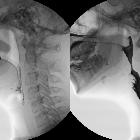Roberts-Syndrom

Femoral-tibial-synostosis
in a child with Roberts syndrome (Pseudothalidomide): a case report. Radiographic examination of the pelvis and the lower limbs showed hypoplastic iliac bones, a hypoplastic left femur with subsequent development of femoral-tibial synostosis. Fixed flexion deformities of the knees was apparent, but with maximal intensity over the left knee. Bilateral fibular aplasia, the ankles showed defective ossification associated with hypoplasia of the distal phalange.

Femoral-tibial-synostosis
in a child with Roberts syndrome (Pseudothalidomide): a case report. Radiographic examination showed, hypoplastic humeri, agenesis of the radii and ulnae, defective ossification of the carpals and hypoplasia of the distal phalanges.

Case of so
called Roberts" syndrome, depicted in John Bingham Roberts report in Annals of Surgery vol. 70, 1924. This report says that infant was of Italian parentage, belonging to a family in which there was a good deal of intermarrying. The parents of this child are first cousins. There are two living children, one eleven years; one, three, both girls. The first child, born in Italy, was a monstrosity and is dead. The two next children are normal in development. Three years ago a girl was born almost identical in deformities with this male child shown the Academy. The girl just mentioned died shortly after birth and this boy did die when fifteen days old.
Roberts syndrome, also known as Roberts-SC phocomelia syndrome, pseudothalidomide syndrome, or Appelt-Gerken-Lenz syndrome, is a rare congenital malformation syndrome.
Clinical presentation
- general
- intrauterine growth restriction
- postnatal growth retardation
- failure to thrive
- thrombocytopenia
- craniofacial
- silvery blonde and sparse scalp hair
- microcephaly
- hypertelorism
- prominent eyes (exophthalmos) due to the shallowness of the orbits
- coloboma
- congenital cataracts
- wide nasal bridge/hypoplastic nasal alae
- facial hemangioma
- midfacial cleft
- bilateral cleft lip/palate
- prominent premaxilla
- delayed eruption of permanent teeth
- dysplastic ears, including hypoplastic lobes
- brain malformations
- skeletal
- phocomelia
- tetramelia
- asymmetrical limb reduction
- oligodactyly
- syndactyly
- flexion joint contractures
- renal malformations
- renal dysplasia
- polycystic kidneys
- horseshoe kidney
- congenital cardiac anomalies
- atrial septal defect
- patent ductus arteriosus
- common atrioventricular canal
- genitourinary malformations
- hypogonadism
- hypospadias
- cryptorchidism
- macropenis
- clitoromegaly
Pathology
It has an autosomal recessive inheritance, and is caused by mutations to the ESCO2 gene .
Radiographic features
- limb
- asymmetrical reduction anomalies of all extremities: ~90%
- synostoses: humeroradial/humero-ulnar, femorotibial
- radial deviation of hands
- oligodactyly/brachydactyly: 80%
- clinodactyly of index finger
- soft tissue syndactyly: 40%
- clubfoot (talipes equinovarus)
- cranial
- facial
- maxillary agenesis
- cleft palate
- orbital hypertelorism
- truncal/rib
- fused ribs
- spina bifida
- platyspondyly
Differential diagnosis
Siehe auch:
- Spina bifida
- Platyspondylie
- Persistierender Ductus arteriosus
- Brachydaktylie
- Atriumseptumdefekt
- Hufeisenniere
- Klinodaktylie
- Kryptorchismus
- Hypertelorismus
- Wormsche Knochen
- Klumpfuß
- Syndaktylie
- Mikrozephalie
- Kolobom
- Intrauterine Wachstumsretardierung
- orbital hypertelorism
- Thalidomid-Embryopathie
- phocomelia
- Hypospadie
- Gaumenspalte
- Brachyzephalie
- oxycephaly
- cleft lip / palate
- alipes equinovarus
und weiter:
- Aseptische Wirbelkörpernekrose
- Vertebra plana
- angeborene renale Anomalien
- Lippen-Kiefer-Gaumen-Spalte
- Myeloschisis
- Radiusaplasie
- Lissenzephalie Typ 2
- classification of paediatric midface anomalies
- Baller-Gerold-Syndrom
- seal limb anomaly
- craniofacial syndromes in children
- Hypospadia penis
- femoro-tibiale Synostose

 Assoziationen und Differentialdiagnosen zu Roberts-Syndrom:
Assoziationen und Differentialdiagnosen zu Roberts-Syndrom:
















